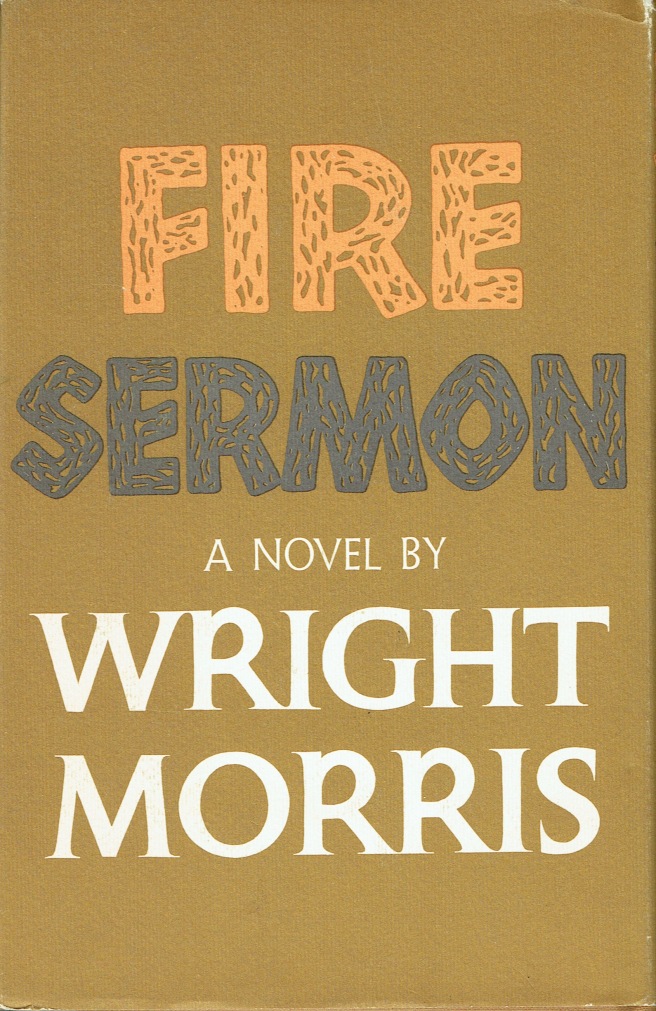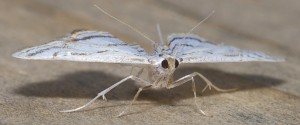
After a mean-spirited coinhabitation of the flu, occupying the couch the way a bad stretch of weather occupies a week, needing something solid, lasting, earthbound to see me through some hours of misery, I took down an old hardcover from a nearby shelf. The book, Fire Sermon by Nebraskan novelist Wright Morris, would do.
The title made me think of T. S. Eliot and The Waste Land—it is after all the title of one of the sections of that poem. What I discovered, quickly, in the first few pages, was a humorous narrative of a boy, one Kermit Oelsligle, orphaned and living with a strange uncle, one Floyd Warner. The story and the style brought to mind The Christmas Story, that holiday film favorite based upon the writings of Jean Shepherd. This passage describing an employee at the local post office suffices for a flavor of Morris’s writing:
“He stands there, his pale face green in the shadow of his visor, the shirtsleeves turned back on his hairless arms. As many as eight or ten pens—ballpoints, felt points, etc.—fit into a plastic holder that protects his shirt pocket, although the only pen the boy has seen him use lies on the metal counter with several rubber stamps. Now and then he takes a puff of the cigarette he balances on the rim of the scales, right over one of the pouches, and there is no way to explain why the place hasn’t burnt down.”
These days when I read I’m always alert to allusions and comments referring to insects (as if spending hours and days looking for real insects is not enough!). Thus the following passage caught my entomological eye:
“He had sat down on a rock, and let his eyes rest on the small hole of some earth creature. Not so big as a prairie dog hole, or a mouse hole, but somewhat larger than most ant holes. Heaped around it, as in most cases, were the sand and pebbles kicked up out of the hole. A tiny volcano: that was how it would look in a photograph. He was struck by the color of one of the pebbles, and took a closer look. Separated from the others, in the palm of his hand, it looked very much like the stub of a pencil, only not so large. One end of it was sharpened to a very fine point, and it had six smooth polished sides. The other end was just a crude stump of dirt and sand, as if left unfinished.”
What the uncle, as a boy, held in his hand was a variety of quartz crystal known as a Pecos diamond. In a glass jar containing agates and crystals, inherited from my rockhound grandparents, are a few of these minute, crystalline pencil stubs, each no bigger than a tic-tac mint, sift their way to the bottom. And I wonder, now, having read this passage, if my grandparent’s adventures took them to the Pecos River country, and if these were authentic Pecos diamonds?
Obviously one of the great pleasures of reading is the synchronicity between reader and what’s written—the surprising way our memories bring living images up from the author’s printed words, the consentaneous way we are allowed to wander off the page and back again. So after wandering off in thought about my grandparents, I return and wander off in a new direction, this time in thought about the insects responsible for excavating these gems.
Mining bees seem the best match for a burrow shaped like a mini volcano, but there are a lot of contenders for insects that might excavate a hole the dimensions of which fall between that of the entrance to an ant hill and that of the entrance to a prairie dog burrow. Digger bees, cicadas, tiger beetles, come to mind. Or sand wasps that flick sand from their burrows through their legs like digging dogs. Or the hunting wasp that meticulously excavates, mouthful by mouthful, and discretely deposits her tailings some distance from the entrance to their burrow. If there were Pecos diamonds where I live, these wasps, like the thread-waisted wasp pictured below, would be likely excavators, hauling the buried gemstones up from the earth so they might glint in the sunlight of summer like tiny sparks of fire. I can’t help but think this would have been a wonderful mechanism for the reappearance of the magic ring in J. R. R. Tolkien’s middle earth saga, better perhaps than its surprising presence at the bottom of a stream.

Fire Sermon, to return to the novel, abruptly ends. After a long road trip in the uncle’s dilapidated car, driving from the California coast to the Nebraska plains (opposite the western movement of earlier generations), giving a lift to a couple of hitchhikers, the house that they have been journeying toward, that contains all the family possessions goes up in flames. And the fire, like that spoken of in the Buddhist Fire Sermon, liberates as it destroys. “Fire purifies” is what the hitchhiker, Joy, tells the boy in the book’s final sentence.

